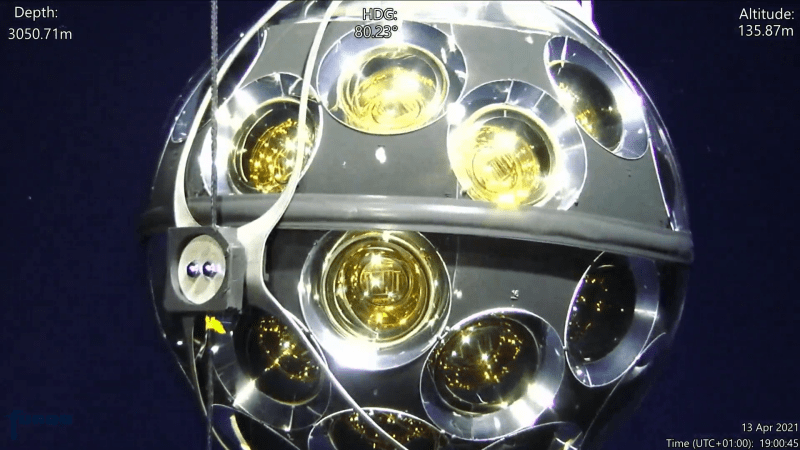On February 13th of 2023, ARCA of the kilometre cubic neutrino telescope (KM3NeT) detected a neutrino with an estimated energy of about 220 PeV. This event, called KM3-230213A, is the most energetic neutrino ever observed. Although extremely abundant in the universe, neutrinos only weakly interact with matter and thus capturing such an event requires very large detectors. Details on this event were published in Nature.
Much like other types of telescopes, KM3NeT uses neutrinos to infer information about remote objects and events in the Universe, ranging from our Sun to other solar systems and galaxies. Due to the weak interaction of neutrinos they cannot be observed like photons, but only indirectly via e.g. photomultipliers that detect the blue-ish light of Cherenkov radiation when the neutrino interacts with a dense medium, such as the deep sea water in the case of ARCA (Astroparticle Research with Cosmics in the Abyss). This particular detector is located at a depth of 3,450 meters off the coast of Sicily with 700 meter tall detection units (DUs) placed 100 meters apart which consist out of many individual spheres filled with detectors and supporting equipment.
With just one of these high-power neutrinos detected it’s hard to say exactly where or what it originated from, but with each additional capture we’ll get a clearer picture. For a fairly new neutrino telescope project it’s also a promising start especially since the project as a whole is still under construction, with additional detectors being installed off the coasts of France and Greece.
















Lol their lucky they don’t use Japanese photo lamps for detection because they tend to go boom all at once when water goes slightly funny.
Guess again. The detectors DO use Japanese (Hamamatsu) photomultiplier tubes.
Not true. They only did a trial run with a couple of Japanese tubes for now. Up unitl 2022 all photomultiplier tubes used in ARCA were supplied by belarussian company which is also manufacturing Sosna-U night vision sights for T-90 tanks.
Not true. They indeed use Japanese Hamamatsu R14374, see here https://arxiv.org/pdf/2203.10048 or here https://www.youtube.com/watch?v=tzxHlLgAahE
Chain reaction when a group of PMTs “went boom” is not a fault of Hamamatsu, but rather the design of SuperKamiokande where it happened, with a huge wall of very densely populated PMTs. Here the detectors are tens of meters apart, so way below “critical density”.
Thanks for this thread. Interesting subtopic.
One of the reasons this is interesting is that there are two possible sources of high energy neutrinos: they can be produced directly by the source, or they can be created along the way to Earth by cosmic rays (“cosmogenic”) due to interactions with various backgrounds. 220 PeV (2E17) is a little low for that, but not crazy low.
There are a lot of projects searching for cosmogenic neutrinos. Generally you need huge areas, comparable to the scale of UHE cosmic rays experiments. Seeing even a few immediately lets you know that they’re there and what the rough estimate of the flux is.
Of course you really want more than one for that…
They use Hamamatsu PMT.